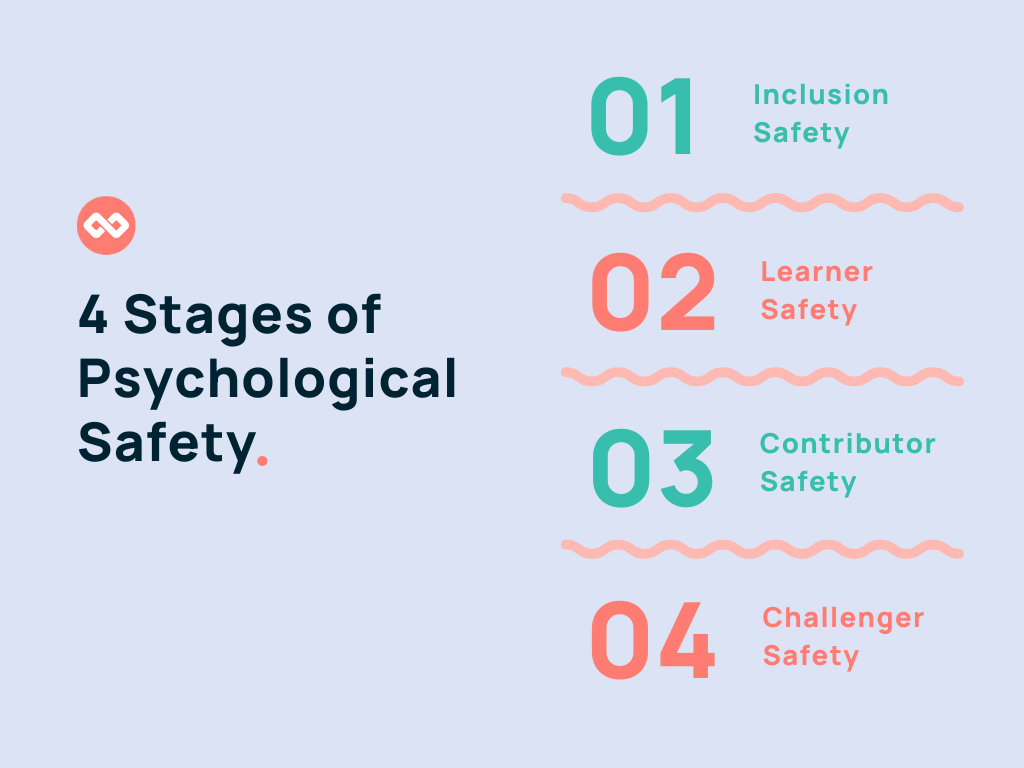Psychological safety is a critical aspect of fostering a healthy and thriving environment, whether it’s in our personal relationships or professional endeavors. It lays the foundation for trust, collaboration, and innovation among individuals and teams. To truly understand its significance, we must explore the four stages of psychological safety – Inclusion Safety, Learner Safety, Contributor Safety, and Challenger Safety.
Understanding Psychological Safety
Before delving into the stages, let’s define psychological safety and highlight its importance.
Psychological safety refers to an environment where individuals feel safe to be their authentic selves, express their thoughts and opinions without fear of negative consequences, and take risks without the fear of embarrassment or rejection. It is crucial because when people feel supported and valued, their performance and overall well-being improve significantly.

Psychological safety is not limited to the workplace; it extends to our personal lives as well. In relationships, it creates a space where individuals can openly communicate, empathize with each other’s experiences, and grow together.
Now, let’s explore how psychological safety unfolds through four key areas:
Building Trust
In the first stage of developing psychological safety, building trust is essential. Trust forms the foundation of any safe environment, whether it’s a workplace or personal relationship. Trust is established through consistent and reliable actions, open communication, and demonstrating empathy towards others. When individuals trust one another, they feel comfortable expressing their thoughts and ideas without fear of judgment or backlash. Some of the most high-performing mentors reiterate the importance of building trust.
Building trust requires time and effort. It involves active listening, showing respect for others’ opinions, and being transparent in our actions. By fostering trust, we create an atmosphere where individuals can take risks and be vulnerable without the fear of negative consequences.
Encouraging Open Communication
Once trust is established, the next stage involves encouraging open communication. In this stage, individuals feel safe to share their thoughts, concerns, and ideas freely. They know that their opinions will be valued and respected, even if they differ from others. Open communication allows for diverse perspectives and collaborative problem-solving.
Encouraging open communication involves creating platforms for dialogue, such as team meetings, brainstorming sessions, or one-on-one conversations. It also requires leaders and individuals to actively listen, seek understanding, and provide quality, constructive feedback. When open communication is fostered, individuals feel empowered to contribute their unique insights, leading to innovation and growth.
Embracing Mistakes and Learning
In the third stage, psychological safety extends to embracing mistakes and learning from them. In a safe environment, individuals are not afraid to make errors or take risks because they understand that failure is an opportunity for growth. They know that their mistakes will be viewed as learning experiences rather than as a reason for punishment or humiliation, cultivating a growth mindset.
Embracing mistakes and learning involves creating a culture that values continuous improvement and personal development. It requires leaders and individuals to provide constructive feedback, offer support and resources for learning, and celebrate efforts rather than just outcomes. When mistakes are embraced, individuals feel encouraged to step out of their comfort zones, explore new ideas, and push boundaries.
Nurturing Collaboration and Innovation
The final stage of psychological safety is nurturing collaboration and innovation. In this stage, individuals feel safe to collaborate, share ideas, and take risks collectively. They trust that their contributions will be acknowledged and appreciated, fostering a sense of belonging and ownership.
Nurturing collaboration and innovation involves creating a culture that values teamwork, encourages diverse perspectives, and rewards experimentation. It requires leaders to create opportunities for cross-functional collaboration, provide resources for innovation, and recognize and celebrate collective achievements. When collaboration and innovation are nurtured, individuals feel motivated to contribute their best work, leading to increased creativity and productivity.
In conclusion, understanding psychological safety is crucial for creating environments where individuals can thrive and reach their full potential. By building trust, encouraging open communication, embracing mistakes and learning, and nurturing collaboration and innovation, we can foster psychological safety in both our personal and professional lives.
Now that you have an overview of each pillar, let’s dive into the four stages of psychological safety:

Stage One: Inclusion Safety
Inclusion safety forms the bedrock of psychological safety. It revolves around creating an inclusive environment where everyone feels valued, respected, and a sense of belonging. This stage emphasizes embracing diversity, recognizing individual strengths, and fostering an environment free from discrimination or bias.
When organizations and communities consciously promote inclusion safety, they open the door to a wealth of perspectives and experiences that a diverse group offers. This not only enhances creativity and innovation but also encourages teamwork and collaboration. By creating an environment where individuals feel comfortable being their authentic selves, organizations can tap into the true potential of their workforce.
Embracing inclusion safety means going beyond mere tolerance and actively working towards creating a culture of acceptance. It involves recognizing and celebrating the unique qualities and contributions that each person brings to the table. In an inclusive environment, differences are seen as strengths rather than obstacles, and individuals are encouraged to express their opinions and ideas freely.
Furthermore, inclusion safety fosters a sense of belonging among individuals. When people feel included and valued, they are more likely to develop a strong connection to the organization or community they are a part of. This sense of belonging not only boosts morale but also increases loyalty and commitment.
Creating an inclusive environment requires a commitment from everyone involved. It involves educating individuals about the importance of inclusion safety and providing them with the tools and resources to actively practice it. Organizations can implement diversity training programs, establish diversity and inclusion committees, support ERGs, and promote open dialogue and communication to ensure that inclusion is embedded in every aspect of the organization’s culture.
In conclusion, inclusion safety is the foundation upon which psychological safety is built. By embracing diversity, recognizing individual strengths, and fostering an environment free from discrimination or bias, organizations and communities can tap into the full potential of their workforce. Inclusion safety not only enhances creativity, teamwork, and collaboration but also fosters a sense of belonging and commitment among individuals. It is a continuous effort that requires the commitment and active participation of everyone involved, but the rewards are well worth it.
Stage Two: Learner Safety
As humans, we are wired to learn and grow. In this stage, learner safety takes center stage. Learner safety encourages a growth mindset, where individuals feel safe to take risks, make mistakes, and learn from them. It involves providing constructive feedback, mentorship, and creating opportunities for continuous learning and development.
When learner safety is nurtured, individuals are more likely to explore new ideas, acquire new skills, and tackle challenges with enthusiasm. This stage paves the way for personal and professional growth that benefits the individual, their team, and the overall organization.
Creating an environment that prioritizes learner safety is crucial for fostering a culture of growth and innovation. When individuals feel safe to take risks, they are more willing to step out of their comfort zones and explore new possibilities. This willingness to experiment and try new things can lead to breakthroughs and innovative solutions to complex problems.
Constructive feedback plays a vital role in learner safety. By providing feedback that focuses on improvement rather than criticism, individuals are empowered to learn from their mistakes and grow. This feedback should be specific, actionable, and delivered in a supportive manner. It should highlight areas of improvement while also recognizing and appreciating the individual’s efforts and progress.
In addition to feedback, mentorship is another important aspect of learner safety. Mentors can provide guidance, support, and share their own experiences to help individuals navigate their learning journey. They can offer advice, share resources, and serve as role models, inspiring learners to reach their full potential.
Creating opportunities for continuous learning and development is also essential for learner safety. This can be done through various means, such as workshops, training programs, conferences, or even online courses. By investing in their employees’ growth, organizations demonstrate their commitment to their employees’ success and create an environment where learning is valued and encouraged.
When learner safety is prioritized, individuals feel empowered to take ownership of their learning and development. They become more proactive in seeking out new knowledge and skills, and they are more likely to embrace challenges as opportunities for growth. This mindset not only benefits the individuals themselves but also has a positive impact on the overall organization.
Learner safety creates an environment where individuals feel safe to take risks, make mistakes, and learn from them. By providing constructive feedback, mentorship, and opportunities for continuous learning and development, organizations can foster a culture of growth and innovation. This stage sets the foundation for personal and professional growth, benefiting both the individual and the organization as a whole.
Stage Three: Contributor Safety
Contributor safety is all about empowering individuals to contribute their unique skills, insights, and perspectives without fear of being judged or criticized. By recognizing and valuing each person’s contributions, organizations can cultivate an environment that encourages participation and collaboration.
When individuals feel safe to contribute, they are not only more engaged and motivated, but they also bring forth innovative solutions and ideas. This stage fosters a culture of trust, where individuals feel supported to take risks and express their creativity. The result? Increased productivity, better problem-solving, and a more harmonious work environment.
Creating a safe environment for contributors involves several key elements. Firstly, it requires establishing clear guidelines and expectations for respectful and inclusive communication. This can include promoting active listening, encouraging open dialogue, and discouraging any form of discrimination or harassment.
Additionally, organizations can implement feedback mechanisms that allow contributors to provide input and suggestions anonymously if they prefer. This can help alleviate any concerns about potential repercussions or negative consequences for sharing ideas or opinions.
Another important aspect of contributor safety is fostering a sense of psychological safety. This means creating an atmosphere where individuals feel comfortable taking risks and sharing their thoughts, even if they are unconventional or different from the norm. Psychological safety encourages creativity and innovation by removing the fear of judgment or ridicule.
Organizations can promote contributor safety by providing resources and support for personal and professional development. This can include offering training programs on effective communication, conflict resolution, and diversity and inclusion. By investing in the growth and well-being of contributors, organizations demonstrate their commitment to creating a safe and supportive environment.
Furthermore, leaders play a vital role in promoting contributor safety. They should lead by example, actively listening to and valuing the contributions of others, and providing constructive feedback in a respectful manner. Leaders should also be accessible and approachable, encouraging open communication and addressing any concerns or issues that may arise.
Contributor safety is crucial for fostering a culture of collaboration, innovation, and productivity. By creating an environment where individuals feel safe to contribute their ideas and perspectives, organizations can harness the full potential of their workforce. Investing in contributor safety not only benefits individuals but also leads to better problem-solving, increased productivity, and a more harmonious work environment.
Stage Four: Challenger Safety
The final stage of psychological safety is challenger safety. At this stage, individuals feel empowered to question the status quo, challenge existing norms, and explore new possibilities. It encourages a culture where constructive criticism is welcomed, and individuals are unafraid to voice their dissenting opinions.
Challenger safety is crucial for spurring innovation and progress. When individuals feel safe to challenge assumptions and propose alternative solutions, organizations can discover new avenues for growth and positive change. By nurturing challenger safety, teams can avoid groupthink and adapt to an ever-evolving world.
Within challenger safety, individuals are encouraged to think critically and analytically. They are empowered to ask thought-provoking questions that challenge the current way of doing things. This stage fosters an environment where brainstorming sessions are vibrant and dynamic, as team members feel free to express their unique perspectives and ideas.
Moreover, challenger safety encourages healthy debate and discussion. It provides a platform for individuals to engage in intellectual conversations, where differing viewpoints are respected and valued. This stage promotes an open-mindedness that allows for the exploration of new possibilities and the discovery of innovative solutions.
Furthermore, challenger safety cultivates a culture of continuous learning and improvement. By encouraging individuals to question existing practices, it pushes teams to constantly seek better ways of doing things. This mindset of continuous improvement is essential for organizations to stay competitive and adapt to the ever-changing demands of the market.
In addition, challenger safety fosters creativity and out-of-the-box thinking. When individuals feel safe to challenge the status quo, they are more likely to come up with unconventional ideas and solutions. This stage encourages individuals to think beyond the boundaries of what is currently known and explore uncharted territories.
Lastly, challenger safety plays a vital role in building resilience within teams. By creating an environment where individuals can voice their dissenting opinions without fear of retribution, it strengthens the team’s ability to handle adversity and overcome challenges. This stage promotes a culture of resilience, where setbacks are seen as opportunities for growth and learning.
In summary, the four stages of psychological safety – Inclusion Safety, Learner Safety, Contributor Safety, and Challenger Safety – are integral to creating a supportive and empowering environment. Each stage builds upon the previous one, reinforcing trust, collaboration, and innovation. By embracing psychological safety, both in our personal and professional lives, we can unlock our full potential and thrive in an ever-changing world. Explore how you can ensure psychological safety in the workplace through mentoring.




